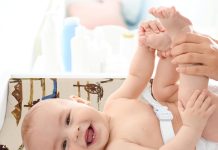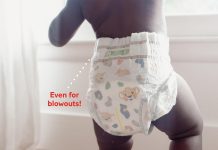When it comes to selecting the perfect changing pad, finding the right size is crucial. With so many options available, it can be overwhelming to figure out which one will best suit your needs. In this article, we will guide you through the process of choosing the ideal size changing pad for you and your baby. From considering the size of your changing area to finding the right balance between comfort and convenience, we’ve got you covered. So, let’s dive in and ensure that every diaper change is a breeze.
Review contents
Considerations for Choosing Size
When it comes to choosing a changing pad for your little one, there are several important considerations to keep in mind. The size of the changing pad is one of the most crucial factors to consider, as it can greatly impact your everyday diaper changing routine. From your baby’s age and size to the available space in your home, here are some key factors to consider when deciding on the right size changing pad for your needs.
Baby’s Age and Size
One of the primary factors to consider when choosing a changing pad size is the age and size of your baby. Newborns and younger babies may require a smaller pad, while older babies and toddlers may need a larger one. It’s important to choose a changing pad that provides enough space for your baby to lie comfortably and securely, ensuring a safe and pleasant diaper changing experience for both of you.
Diaper Changing Area
Another consideration is the size of the diaper changing area in your home. Whether you have a dedicated changing table or you plan on changing your baby’s diapers on a bed or dresser, it’s important to measure the available space to ensure that the changing pad will fit comfortably. Additionally, consider the height and width of the changing surface to ensure that the pad will be a good fit and provide a stable and secure platform for diaper changes.
Portability
If you often find yourself on the go or travel frequently, you may also want to consider the portability of the changing pad. Portable changing pads come in a variety of sizes, ranging from compact options that can easily fit in your diaper bag to foldable options that can be carried in larger tote bags or backpacks. Choosing a size that suits your lifestyle and allows for easy transport can make diaper changes a breeze no matter where you are.
Available Space
In addition to considering the size of the diaper changing area, it’s also important to take into account the available space in your home. If you have limited space, you may need to opt for a smaller changing pad or explore space-saving options like wall-mounted or foldable changing stations. On the other hand, if you have ample space, you may have the flexibility to choose a larger changing pad that offers extra features and comfort for your baby.
Budget
Of course, budget plays a role in any purchasing decision. Changing pads come in a range of prices, and larger or more feature-rich options tend to be more expensive. It’s important to set a budget that you’re comfortable with and consider what features are most important to you. While it’s important to find a changing pad that meets your needs, it’s also crucial to find one that fits within your budgetary constraints.
Standard Changing Pad Sizes
When it comes to standard changing pad sizes, there are a few common options that you’ll come across while shopping. These sizes are often considered the standard and are widely available, making them a popular choice among parents. Here are some of the most common standard sizes and their dimensions.
Standard Size Options
The most common standard changing pad sizes include:
- Small standard: This size measures approximately 16 inches wide by 28 inches long and is suitable for newborns and smaller babies.
- Medium standard: This size measures around 17 inches wide by 31 inches long, offering a bit more room for larger babies.
- Large standard: This larger option measures approximately 18 inches wide by 34 inches long and provides ample space for older babies and toddlers.
These sizes are designed to fit most standard changing tables and provide a comfortable and secure space for diaper changes.
Standard Dimensions
While the specific dimensions may vary slightly depending on the brand and model, standard changing pads generally fall within the following ranges:
- Width: 16 to 18 inches
- Length: 28 to 34 inches
- Thickness: 1 to 4 inches
Keep in mind that these dimensions are approximate and can vary slightly. It’s always a good idea to check the product specifications to ensure that a standard-sized changing pad will fit your intended changing surface comfortably.
Portable Changing Pad Sizes
If you’re frequently on the go or prefer a more compact option, portable changing pads are a great choice. These pads are designed to be lightweight, foldable, and easy to carry, allowing you to change your baby’s diapers anytime, anywhere. Here are some common sizes and dimensions for portable changing pads.
Compact and Foldable Options
Many portable changing pads are designed to be compact and foldable, making them easy to pack in your diaper bag or tote. While the exact dimensions can vary depending on the brand and design, most compact and foldable changing pads measure around 10 to 12 inches wide by 20 to 25 inches long when folded. When opened up for diaper changes, they tend to expand to approximately 18 to 20 inches wide by 28 to 32 inches long, providing a comfortable and hygienic space for your baby.
Portable Dimensions
Portable changing pads are typically thinner than standard changing pads, ranging from 0.5 to 2 inches thick. This slim design allows for easy storage and transportation while still providing a cushioned and comfortable surface for your baby. The dimensions and thickness of portable changing pads can vary, so it’s important to consider your baby’s size and your personal preferences when choosing a portable option.
Ergonomic Features
Choosing a changing pad with ergonomic features can greatly enhance your baby’s comfort and safety during diaper changes. Here are a few key ergonomic features to look out for when selecting a changing pad.
Contoured Design
Many changing pads feature a contoured design, which means they are slightly curved or have raised sides to help cradle your baby and keep them in place during diaper changes. This design offers added support and prevents your baby from rolling off the sides of the pad, providing peace of mind and ensuring a secure and comfortable experience for both of you.
Raised Edges
In addition to a contoured design, some changing pads also feature raised edges. These raised edges act as a barrier, preventing your baby from sliding or rolling off the pad. Raised edges can provide an extra layer of safety, especially when dealing with wiggly or active babies.
Padding Thickness
The thickness of the padding on a changing pad can also contribute to its overall ergonomic design. Opting for a pad with adequate padding can provide a more comfortable and cushioned surface for your baby to lie on. Thicker padding can help distribute your baby’s weight more evenly, reducing pressure points and increasing overall comfort during diaper changes.
Materials and Durability
The materials used in the construction of a changing pad can greatly impact its durability and functionality. Considering the materials is essential to ensure that you choose a pad that is both safe for your baby and built to withstand everyday use. Here are a few factors to consider when it comes to materials and durability.
Quality Materials
When selecting a changing pad, it’s important to look for options made with high-quality materials. Opt for pads made from non-toxic and hypoallergenic materials that are safe for your baby’s delicate skin. Materials such as PVC-free vinyl and foam are commonly used in changing pads due to their waterproof and easy-to-clean properties.
Waterproofing
Spills and accidents are bound to happen during diaper changes, so choosing a changing pad with waterproofing features is key. Look for pads with a waterproof or water-resistant cover to help protect against leaks and spills. This feature not only makes cleaning up messes easier but also helps prolong the life of the changing pad.
Easy to Clean
Changing pads can quickly become soiled with diaper messes, so it’s important to choose one that is easy to clean. Look for pads with removable and machine-washable covers that can be easily wiped down or thrown in the washing machine for a thorough cleaning. Additionally, consider the ease of cleaning the pad itself, as some models may be more prone to trapping liquids or odors.
Safety Considerations
Ensuring the safety of your little one during diaper changes is paramount. When choosing a changing pad, there are several safety considerations to keep in mind to provide a secure and worry-free environment for your baby.
Non-Toxic Materials
Safety should always be your top priority when selecting a changing pad. Look for options made from non-toxic materials that have undergone safety testing and meet relevant safety standards. Avoid changing pads that contain harmful chemicals such as phthalates or lead, as these substances can pose health risks to your baby.
Safety Straps
Many changing pads come equipped with safety straps to help secure your baby in place during diaper changes. These straps typically go around your baby’s waist or torso and provide an additional layer of security. Ensure that the safety straps are adjustable and easy to use, allowing for a snug yet comfortable fit.
Grip and Non-Slip Surface
A changing pad with a non-slip surface is essential for ensuring your baby’s safety during diaper changes. Look for pads that feature a grip or textured surface to prevent your baby from sliding or shifting during changes. A non-slip surface provides added stability and reduces the risk of accidents.
Reviews and Recommendations
When it comes to making informed purchasing decisions, it’s always helpful to read reviews and seek recommendations from other parents. Here are some sources to consider when researching changing pads.
Online Reviews
Online retailers and parenting websites often feature customer reviews and ratings for various changing pad options. These reviews can provide valuable insights into the quality, durability, and performance of a particular changing pad. Reading through both positive and negative reviews can help you gauge the pros and cons of different models and make an informed decision.
Parent Recommendations
Reach out to fellow parents or join online parenting communities to gather recommendations for changing pads. Other parents’ experiences and opinions can offer valuable insight, especially if they have similar needs and preferences to yours. Asking for recommendations can also help you discover lesser-known brands or models that may be a perfect fit for your needs.
Brand Reputation
Consider the reputation and track record of different changing pad brands. Established and well-known brands often have a long history of producing high-quality and reliable products. Researching the brand’s reputation can give you an idea of their commitment to safety, durability, and customer satisfaction.
Testing and Compatibility
Before making a final decision, it’s important to test the size and compatibility of a changing pad. Here are a few factors to consider when testing and assessing the pad’s suitability for your needs.
Fitting In Diaper Bags
If portability is a priority, test the changing pad’s size and fit in your diaper bag. Ensure that it can comfortably fit alongside other essentials such as diapers, wipes, and changing supplies without being too bulky or taking up excessive space.
Compatibility with Changing Tables
If you have a dedicated changing table, check the dimensions and design of the pad to ensure that it will fit securely on your changing surface. Measure the width and length of your changing table and compare it to the dimensions of the changing pad to ensure a proper fit. Additionally, consider any safety features or attachments on your changing table that may affect the compatibility of the pad.
Testing the Size
Finally, test the size and fit of the changing pad with your baby. Lay your baby down on the pad and assess whether they have enough space to lie comfortably. Ensure that the pad provides adequate support and security, and check for any signs of discomfort or instability during the trial run.
Additional Features and Accessories
Beyond the basic considerations, there are several additional features and accessories that you may want to explore when choosing a changing pad. These features can enhance functionality and convenience, making diaper changes a smoother and more enjoyable experience.
Attached Toy Bars
Some changing pads come with attached toy bars or loops where you can hang toys or accessories to keep your baby entertained during diaper changes. These features can help distract and engage your baby, making the process more enjoyable for both of you. Consider whether these attached toy bars are an essential feature for you and your baby.
Pockets and Compartments
If you prefer to keep your diaper changing essentials organized and easily accessible, consider a changing pad with built-in pockets or compartments. These storage options allow you to keep diapers, wipes, creams, and other supplies within reach, eliminating the need to search for items during diaper changes.
Changing Pad Covers
Changing pad covers can help protect the pad from stains and extend its lifespan. Look for covers made from soft, breathable, and washable materials that are easy to remove and replace. Having multiple covers on hand can also be convenient, allowing you to switch them out easily between washes or for different occasions.
Conclusion
Choosing the right size changing pad for your baby is an important decision that can greatly impact your daily routine. By considering factors such as your baby’s age and size, the available space in your home, and your budget, you can find a changing pad that meets your needs and preferences. Additionally, paying attention to ergonomic features, materials and durability, safety considerations, reviews and recommendations, testing and compatibility, and any additional features or accessories can help you make an informed decision. So, take your time, do your research, and find a changing pad that will provide comfort, convenience, and safety for both you and your little one.






























